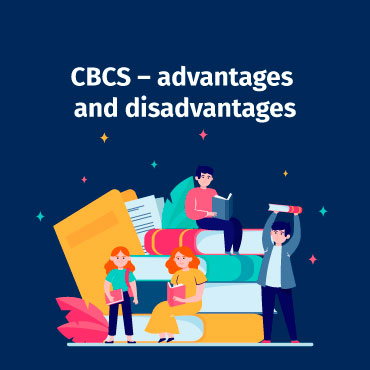“Education is the key to opportunity. It is a ticket out of poverty”
– George W. Bush
Education must be the way out of poverty. It enlightens the students with the adequate knowledge to identify, analyse, and seize the opportunity they are presented with. Thus, the kind of education students receive must be able to help them eradicate poverty and mediocrity from their life towards a better life and nation. One of the major reasons for poverty in India is unemployment. There is an imbalance in the number of people graduating and their employment rate. This major gap in employment can be attributed to the education system that is very rigid in terms of the courses offered. There is a mismatch in the employability skills that a student has, to the ones expected by their employer. In order to combat the gap, India introduced the CBCS (Choice Based Credit System), a famous educational pedagogy followed abroad.
CBCS -Choice Based Credit System:
Choice Based Credit system -CBCS is a student-centric/ learner-centric educational pedagogy that helps the students to choose the subjects they wanted to learn. This will help a lot of students to have additional venues for careers. For example, medical students can learn law or history or psychology as their supplementary subjects. In this manner, they will have opportunities in other fields too instead of being dependent on one field. It diversifies the employment opportunities for the students. Ministry of Human Resource Department, Government of India, has taken initiatives to bring about amendments in the new Education Policy. They look forward to bringing a change in the overall pedagogy of teaching and learning, examination and evaluation system. A holistic approach towards changing the educational system for a better future and better citizens. Higher secondary is a crucial aspect of a student’s education. It decides the direction of propulsion of their career. In contrast to the conventional thought that students at a young age cannot decide for themselves, CBCS allows them to decide and pursue. It allows them to explore their passion and field of interest.
Advantages- CBCS:
- The students have the choice to study the course they wanted to.
- They don’t have the necessity to wait until graduation to get a job. The rate of employability among students will increase.
- The students can combine and learn any two streams of subject and graduate. For eg: a student with psychology majors can also learn history and science.
- The employability skills of the students gain a steady rise and hence the poverty rate is decreased. A doctor can land a basic executive level branding of marketing sector job because of the choice based credit system.
- The burnout rate among the students at an early stage eventually decreases as they can jump between jobs if the current one drains them.
- The students can learn half the course in one university and the other half in another university for the expertise and opportunities they provide.
- With CBCS, the transfer of students becomes easier as the credits will only be transferred.
- Each student will have a unique timetable to follow.
- The students have the liberty to start and finish their semester at their own pace.
- The CBCS educational system plants a sense of responsibility and leadership in taking the task at hand and completing it.
- The students have the full power to choose the subject they wanted to study and from the faculty, they wanted to learn.
- The CBCS follows a semester pattern that helps reduce the burden of lessons on both the students and the faculty.
- All the students have equal access to all the resources. Off-campus, on-campus or digital campus (with LMS)
- This system benefits the students who have to take care of their families at a younger age than those trying to study and work to support their families.
- CBCS educational system creates a venue for innovations as a result of cross-culture studies and research-based fields.
Disadvantages of CBCS:
- The workload of teachers increases with the multiple subjects and assessments.
- Matching the main program with the sift courses will be a challenge for the college
- As CBCS has the option of taking or not taking credits, the institutions will face an extra burden from the admin side.
- The students will lose the need to master one subject/topic.
- The students might lose their seriousness in exams.
- Teachers need to spend more time prepping for examinations and setting question papers.
- It might lead to an increase in infrastructure to accommodate the students.
- It becomes tough to determine the actual marks of the students.
Conclusion:
A CBCS is an answer to a better future when implemented with a digital campus with a unified LMS (Learning management software) and SIS (Student Information system) with additional administration management facilities like Camu’s digital campus. Their CBCS is easy to implement and helps secure the institutions’ administration activities, student and teacher activities, virtual classrooms, and a robust proctoring facility.











